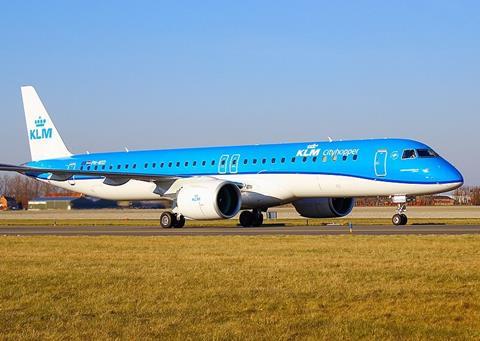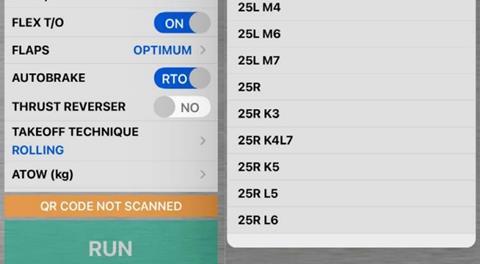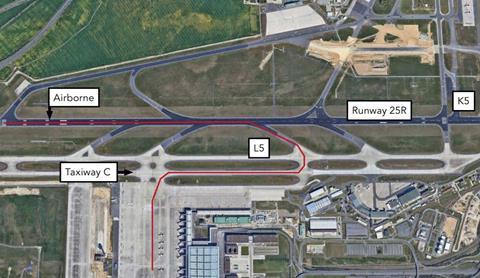Investigators believe touchscreen ergonomic design contributed to a take-off incident involving an Embraer 195-E2, after both pilots independently selected the wrong intersection for departure.
The KLM Cityhopper aircraft was departing from Berlin Brandenburg on 12 September 2021, using intersection L5 on runway 25R.
But when the pilots conducted take-off calculations, using a handheld tablet to access the electronic flightbag, both inadvertently selected the K5 intersection.
The flightbag’s performance application, known as ‘ePerf’, used touchscreen pull-down menus for selecting runways and intersections. Intersection K5 was listed just above the correct L5, and both pilots accidently tapped the wrong one.
“It is commonly understood that selection errors occur when working on a touchscreen with finger-touch interaction,” says the Dutch Safety Board.
“First, there is no system feedback about the location of the finger prior to completing selections by tapping the screen. Second, the ‘fat finger’ problem means that the finger is a large and relatively crude pointing device for small targets.
“Items that are close to the desired target can be accidentally selected.”

Berlin’s runway 25R is 3,600m in length. Intersection K5 is near the beginning of the runway, while L5 is 1,320m further along. This meant the take-off calculation, which should have been based on a relatively short runway, instead used a much longer one – requiring less thrust from the engines.
As a result, the performance application on the flightbag instructed the pilots to use a higher assumed outside air temperature, 57° rather than 35°, to enable lower thrust.
While a correct L5 departure calculation would have generated a V1 speed of 120kt, and shown a higher flap setting, the K5 calculation indicated a V1 of 139kt and reduced flap.

Cockpit-voice recorder information was not available to investigators.
But the inquiry believes the pilots cross-checked their calculations using the figures presented by the performance application – which were naturally the same, because both pilots had unwittingly selected the same incorrect intersection.
When the aircraft approached the runway, it passed a sign marking the L5 intersection, in line with the crew’s expectations, and when the calculated engine thrust – 75% of N1 – was displayed, the crew felt it was within the reasonable range.
“Trust of the crew in the calculated values by the performance calculation application may also have been a contributing factor to the occurrence,” says the safety board. “On top of that, it is the dominant response, common and trained, that pilots do not add thrust during the take-off.”
As the aircraft rolled for take-off, the reduced thrust setting resulted in slow acceleration. The aircraft lifted off, at its calculated rotation speed, about 144m from the runway end, crossing the threshold at 20ft. The remaining paving, including the clearway, totalled some 443m.
None of the 92 passengers and five crew members on board the twinjet (PH-NXD) was injured, and the aircraft was undamaged.

The inquiry’s analysis found the crew had flown different variants of the Embraer E-Jet – including the E175, E190 and E195-E2 – in four days of pairing.
“Although switching between aircraft variants does not take much effort according to the crew, switching between Embraer aircraft variants may affect the feel for take-off parameters of a specific variant,” it says, but adds that it “could not determine” whether this contributed to the occurrence.
Investigators observed that the take-off performance application did not provide visual feedback about the selected runway and intersection.
Embraer had looked at adding a visual synoptic to the application, but it was not previously viewed by operators as a priority. But it has since reconsidered and aims to introduce such a feature, with a graphical representation of the runway, in 2024.
The airframer has also been working modify the software in order to reduce inadvertent selections, including a two-step process to separate runways and intersections, and using on-screen highlighting of selected intersections to aid error detection.
But the inquiry says Embraer, unlike some other manufacturers, has no plans to develop on-board systems that provide “hard barriers” against erroneous data entry. The investigation recommends that the airframer rethinks this strategy, and starts developing an independent system to detect gross input errors in take-off calculations, or alert the crew to abnormally-low acceleration or insufficient runway length.


























